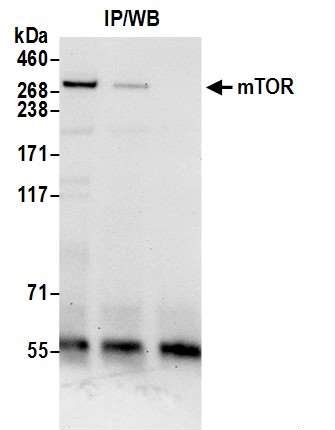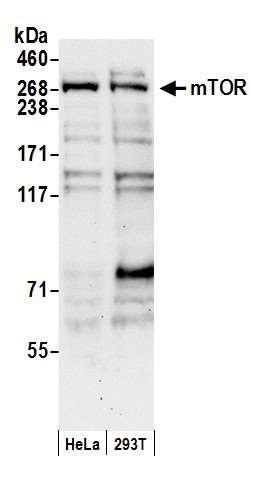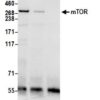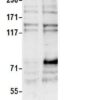Anti-mTOR Antibody (13036)
$518.00
SKU: 13036
Categories: Antibody Products, Enzymes and Enzyme Inhibitor Antibodies, Products
Overview
Product Name Anti-mTOR Antibody (13036)
Description Anti-mTOR Rabbit Polyclonal Antibody
Target mTOR
Species Reactivity Human, Mouse, Rat
Applications WB,IP
Host Rabbit
Clonality Polyclonal
Isotype Whole IgG
Immunogen Synthetic peptide representing a portion of the protein encoded in part by exons 5 and 6 (LocusLink ID 1981).
Properties
Form Liquid
Concentration Lot Specific
Formulation Tris-citrate/phosphate buffer, pH 7 to 8 containing 0.09% Sodium Azide
Buffer Formulation Tris
Buffer pH pH 7.8
Buffer Anti-Microbial 0.1% Sodium Azide
Format Purified
Purification Purified by immunoaffinity chromatography
Specificity Information
Specificity This antibody reacts with human, mouse and rat. Antibody is affinity purified.
Target Name Serine/threonine-protein kinase mTOR
Target ID mTOR
Uniprot ID P42345
Alternative Names EC 2.7.11.1, FK506-binding protein 12-rapamycin complex-associated protein 1, FKBP12-rapamycin complex-associated protein, Mammalian target of rapamycin, mTOR, Mechanistic target of rapamycin, Rapamycin and FKBP12 target 1, Rapamycin target protein 1
Gene Name MTOR
Accession Number NP_004949
Sequence Location Endoplasmic reticulum membrane, Golgi apparatus membrane, Mitochondrion outer membrane, Lysosome, Cytoplasm, Nucleus, PML body, Microsome membrane, Lysosome membrane, Cytoplasmic vesicle, phagosome
Biological Function Serine/threonine protein kinase which is a central regulator of cellular metabolism, growth and survival in response to hormones, growth factors, nutrients, energy and stress signals (PubMed:12087098, PubMed:12150925, PubMed:12150926, PubMed:12231510, PubMed:12718876, PubMed:14651849, PubMed:15268862, PubMed:15467718, PubMed:15545625, PubMed:15718470, PubMed:18497260, PubMed:18762023, PubMed:18925875, PubMed:20516213, PubMed:20537536, PubMed:21659604, PubMed:23429703, PubMed:23429704, PubMed:25799227, PubMed:26018084). MTOR directly or indirectly regulates the phosphorylation of at least 800 proteins. Functions as part of 2 structurally and functionally distinct signaling complexes mTORC1 and mTORC2 (mTOR complex 1 and 2) (PubMed:15268862, PubMed:15467718, PubMed:18925875, PubMed:18497260, PubMed:20516213, PubMed:21576368, PubMed:21659604, PubMed:23429704). Activated mTORC1 up-regulates protein synthesis by phosphorylating key regulators of mRNA translation and ribosome synthesis (PubMed:12087098, PubMed:12150925, PubMed:12150926, PubMed:12231510, PubMed:12718876, PubMed:14651849, PubMed:15268862, PubMed:15467718, PubMed:15545625, PubMed:15718470, PubMed:18497260, PubMed:18762023, PubMed:18925875, PubMed:20516213, PubMed:20537536, PubMed:21659604, PubMed:23429703, PubMed:23429704, PubMed:25799227, PubMed:26018084). This includes phosphorylation of EIF4EBP1 and release of its inhibition toward the elongation initiation factor 4E (eiF4E) (By similarity). Moreover, phosphorylates and activates RPS6KB1 and RPS6KB2 that promote protein synthesis by modulating the activity of their downstream targets including ribosomal protein S6, eukaryotic translation initiation factor EIF4B, and the inhibitor of translation initiation PDCD4 (PubMed:12150925, PubMed:12087098, PubMed:18925875). This also includes mTORC1 signaling cascade controlling the MiT/TFE factors TFEB and TFE3: in the presence of nutrients, mediates phosphorylation of TFEB and TFE3, promoting their cytosolic retention and inactivation (PubMed:22576015, PubMed:22343943, PubMed:22692423). Upon starvation or lysosomal stress, inhibition of mTORC1 induces dephosphorylation and nuclear translocation of TFEB and TFE3, promoting their transcription factor activity (PubMed:22576015, PubMed:22343943, PubMed:22692423). Stimulates the pyrimidine biosynthesis pathway, both by acute regulation through RPS6KB1-mediated phosphorylation of the biosynthetic enzyme CAD, and delayed regulation, through transcriptional enhancement of the pentose phosphate pathway which produces 5-phosphoribosyl-1-pyrophosphate (PRPP), an allosteric activator of CAD at a later step in synthesis, this function is dependent on the mTORC1 complex (PubMed:23429704, PubMed:23429703). Regulates ribosome synthesis by activating RNA polymerase III-dependent transcription through phosphorylation and inhibition of MAF1 an RNA polymerase III-repressor (PubMed:20516213). In parallel to protein synthesis, also regulates lipid synthesis through SREBF1/SREBP1 and LPIN1 (By similarity). To maintain energy homeostasis mTORC1 may also regulate mitochondrial biogenesis through regulation of PPARGC1A (By similarity). mTORC1 also negatively regulates autophagy through phosphorylation of ULK1 (By similarity). Under nutrient sufficiency, phosphorylates ULK1 at 'Ser-758', disrupting the interaction with AMPK and preventing activation of ULK1 (By similarity). Also prevents autophagy through phosphorylation of the autophagy inhibitor DAP (PubMed:20537536). Also prevents autophagy by phosphorylating RUBCNL/Pacer under nutrient-rich conditions (PubMed:30704899). Prevents autophagy by mediating phosphorylation of AMBRA1, thereby inhibiting AMBRA1 ability to mediate ubiquitination of ULK1 and interaction between AMBRA1 and PPP2CA (PubMed:23524951, PubMed:25438055). mTORC1 exerts a feedback control on upstream growth factor signaling that includes phosphorylation and activation of GRB10 a INSR-dependent signaling suppressor (PubMed:21659604). Among other potential targets mTORC1 may phosphorylate CLIP1 and regulate microtubules (PubMed:12231510). As part of the mTORC2 complex MTOR may regulate other cellular processes including survival and organization of the cytoskeleton (PubMed:15268862, PubMed:15467718). Plays a critical role in the phosphorylation at 'Ser-473' of AKT1, a pro-survival effector of phosphoinositide 3-kinase, facilitating its activation by PDK1 (PubMed:15718470). mTORC2 may regulate the actin cytoskeleton, through phosphorylation of PRKCA, PXN and activation of the Rho-type guanine nucleotide exchange factors RHOA and RAC1A or RAC1B (PubMed:15268862). mTORC2 also regulates the phosphorylation of SGK1 at 'Ser-422' (PubMed:18925875). Regulates osteoclastogenesis by adjusting the expression of CEBPB isoforms (By similarity). Plays an important regulatory role in the circadian clock function; regulates period length and rhythm amplitude of the suprachiasmatic nucleus (SCN) and liver clocks (By similarity). Phosphorylates SQSTM1, promoting interaction between SQSTM1 and KEAP1 and subsequent inactivation of the BCR(KEAP1) complex (By similarity). {UniProtKB:P42346, UniProtKB:Q9JLN9, PubMed:12087098, PubMed:12150925, PubMed:12150926, PubMed:12231510, PubMed:12718876, PubMed:14651849, PubMed:15268862, PubMed:15467718, PubMed:15545625, PubMed:15718470, PubMed:18497260, PubMed:18762023, PubMed:18925875, PubMed:20516213, PubMed:20537536, PubMed:21576368, PubMed:21659604, PubMed:22343943, PubMed:22576015, PubMed:22692423, PubMed:23429703, PubMed:23429704, PubMed:23524951, PubMed:25438055, PubMed:25799227, PubMed:26018084, PubMed:30704899}.
Research Areas Enzymes
Application Images



Description Detection of human mTOR by western blot of immunoprecipitates. Samples: Whole cell lysate (0.5 or 1.0 mg per IP reaction; 20% of IP loaded) from HeLa cells prepared using NETN lysis buffer. Antibody: Affinity purified rabbit anti-mTOR antibody 13036 (lot 13036-2) used for IP at 6 µg per reaction. mTOR was also immunoprecipitated by rabbit anti-mTOR antibody. For blotting immunoprecipitated mTOR, 13036 was used at 1 µg/ml. Detection: Chemiluminescence with an exposure time of 30 seconds.

Description Detection of human mTOR by western blot. Samples: Whole cell lysate (50 µg) from HeLa and HEK293T cells prepared using NETN lysis buffer. Antibody: Affinity purified rabbit anti-mTOR antibody 13036 (lot 13036-2) used for WB at 0.4 µg/ml. Detection: Chemiluminescence with an exposure time of 30 seconds.
Handling
Storage Store at 2 - 8°C. Antibody is stable at 2 - 8°C for 1 year.
Dilution Instructions Dilute in PBS or medium which is identical to that used in the assay system.
Application Instructions Western Blot: 0.1-1 ug/ml.Note: Overnight incubation at 4°C is recommended for primary antibody. MTOR requires detergent and extended Western Blotting transfer times (e.g. in 5% acrylamide gels to PVDF, use 50V for 3 hours in CAPS buffer with 10% methanol and 0.1% SDS).
Immunoprecipitation: Use Catalog Number 13034.
Immunoprecipitation: Use Catalog Number 13034.
References & Data Sheet
Data Sheet  Download PDF Data Sheet
Download PDF Data Sheet
 Download PDF Data Sheet
Download PDF Data Sheet





